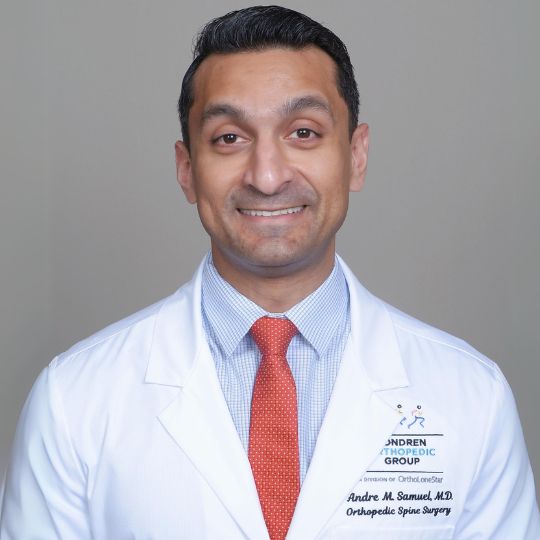Herniated Disc Specialist
As we age, the discs in the spine can become dehydrated, rigid and can weaken due to normal wear-and-tear. This process can cause a herniated disc in the neck and/or back. Herniated discs can cause mild or severe problems with daily activities. Cervical herniated disc specialist, Doctor Andre M. Samuel, orthopedic spine expert offers both surgical and non-surgical treatment options for patients in the Clear Lake, Houston, and Sugar Land, Texas area, who are experiencing symptoms associated with a cervical disc herniation. Contact Dr. Samuel’s team today!

What is a cervical disc herniation?
The first seven vertebrae in the spinal column, beginning at the base of the skull, make up the cervical spine. A tough and rubbery disc separates each of these vertebrae and reduces friction by acting as a shock absorber. Over time, this structure may weaken causing the jelly-like nucleus to bulge against the spinal cord or spinal nerve roots. A sudden and traumatic injury, such as a motor vehicle collision, can result in a cervical disc rupture. While a cervical disc herniation is most common among individuals in their 30s and 40s, older adults are also at risk of developing a cervical disc herniation, after repetitive wear and tear on their disc from day-to-day regular activity.. Dr. Andre M. Samuel, orthopedic spinal specialist serving the Clear Lake, Houston, Sugar Land, Texas area, has extensive experience and training from of of the nation’s top hospital for treatment of patients who have experienced cervical radiculopathy. In addition, Dr. Samuel has published extensively on the topic of cervical radiculopathy and conducted research furthering our understanding of this condition. as substantial experience, in treating patients who have experienced a cervical disc herniation.

What causes a cervical disc herniation?
A cervical disc herniation can result from an injury or occur spontaneously after repetitive day-to-day activity. The natural aging process causes dehydration of the spinal discs creating a more rigid and weaker structure. The gel-like nucleus of the spinal disc may rupture or bulge through a tear in the disc wall. This leads to pressure directly against the nerve root causing irritation and inflammation of the nerves. Certain occupational and recreational activities, genetics, and smoking can also cause early disc degeneration.
What are the symptoms of a cervical disc herniation?
One of the most common complaints of a cervical disc herniation is pain that radiates from the neck into one of the upper extremities. This pain may travel as far as the hand and fingers. Some other common symptoms of a cervical disc herniation include:
- Pain with neck bending or turning the head
- Muscle spasms
- Loss of upper extremity muscle strength
- Decreased sensation
- Numbness and/or tingling of the upper extremity
- Loss of handgrip strength
How is a cervical disc herniation diagnosed?
A thorough medical history and physical examination are performed by Dr. Samuel to diagnose a cervical disc herniation. The neck and upper extremities are evaluated for any signs of muscle weakness, decreased sensation, or abnormalities in the nerve reflexes. Advanced imaging, such as magnetic resonance imaging (MRI), or nerve conduction studies, such as electromyography, may be requested to better delineate the affected cervical disc.
What is the treatment for a cervical disc herniation?
Non-surgical treatment:
Most patients with a cervical disc herniation often find their symptoms completely resolved with 4 to 6 weeks of conservative therapies. Dr. Samuel recommends non-steroidal anti-inflammatories (NSAIDs) as well as over-the-counter analgesics, such as Tylenol, to help alleviate pain. Occasionally a short course of oral steroids may be warranted. Dr. Samuel may also referred you to have targeted steroid injection to be administered directly to the affected nerve root. Some patients find relief from wearing a soft cervical collar for a short period of time. Physical therapy is also strongly encouraged to strengthen the neck muscles and prevent re-injury to the spine.
Surgical treatment:
Patients who trialed conservative treatment measures with little to no symptom relief are candidates for surgical intervention. There are a number of different surgical procedures available to correct a cervical disc herniation. Dr. Samuel will consider a number of patient factors, such as age, medical history, and severity of symptoms, to determine which of the following techniques is most appropriate.
- Cervical Disc Replacement (CDR): The herniated disc is completely removed from an incision on the front of the neck and replaced with an artificial disc that preserves motion
- Anterior Cervical Discectomy & Fusion (ACDF). The ruptured disc is completely removed from an incision on the front of the neck. The space is then filled with a bone graft that will fuse to the surrounding vertebrae. This is used for treating discs that have becoming severely arthritic.
- Artificial Disc Replacement. The herniated disc is replaced with an artificial disc to preserve neck motion.
- Posterior Cervical Foraminotomy. The cervical disc herniation is removed through a small incision on the back of the neck. The minimally invasive technique allows less injury to the surrounding muscles and preserves the remainder of normal healthy disc



